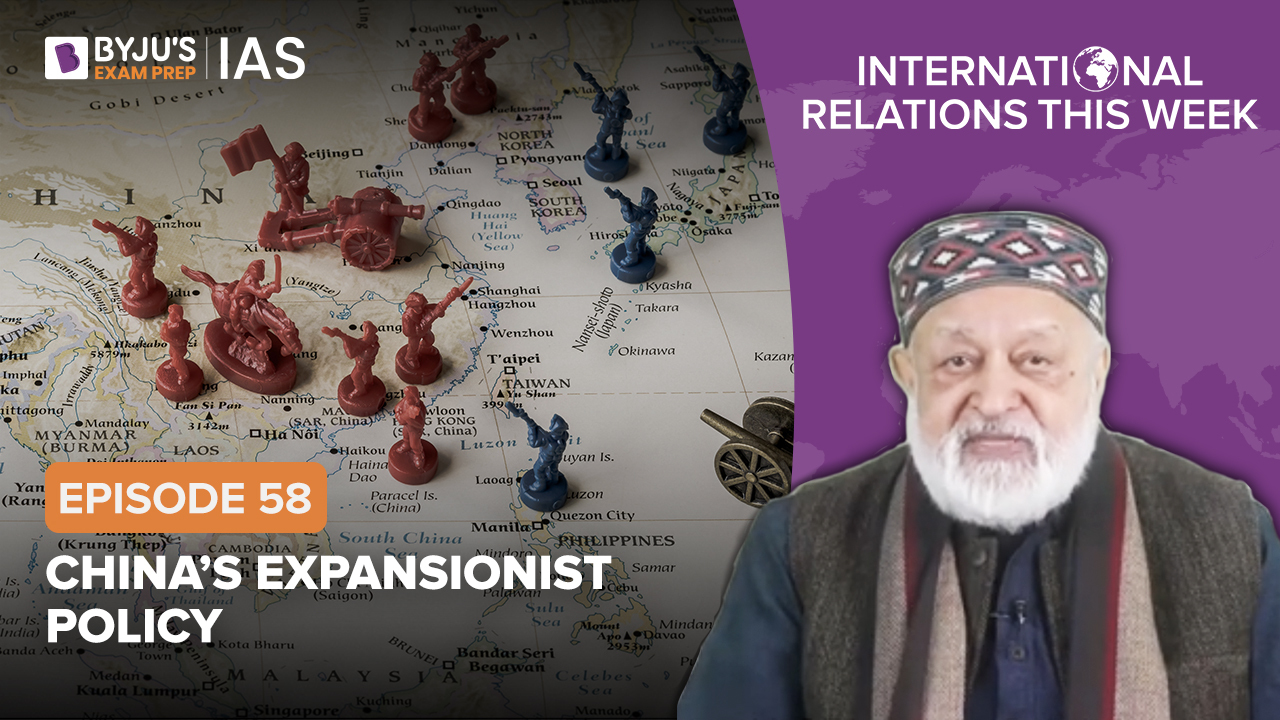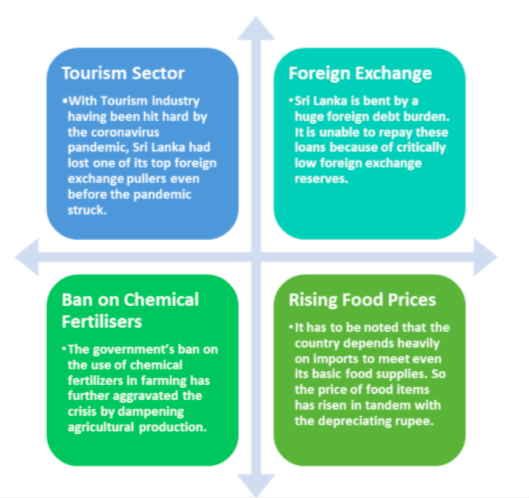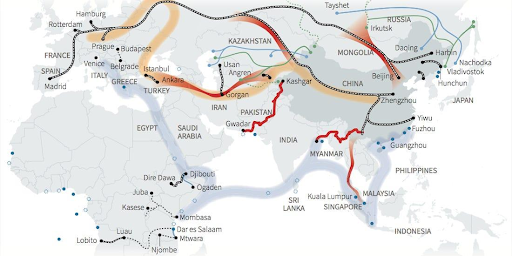International relations is a very important segment of the UPSC syllabus. In this series, we present an analysis of the most important international issues and developments that occurred over the past week relevant for the IAS exam. In this article, you can learn more about the crisis in Sri Lanka, the expansion of China and the latest developments in the African countries of Ethiopia and Sudan.

TABLE OF CONTENTS
1. Sri Lankan Crisis 2. Developments In Sudan And Ethiopia 3. China’s Expansion
Economic Crisis in Sri Lanka:
- What is the Sri-Lankan Crisis?
- This economic crisis is a product of decades of Sri Lanka’s economic growth model.
- Sri Lanka continued to sustain its economic growth by borrowing through sovereign bonds and international bilateral commercial loans, generally at high-interest rates and short payback periods.
- Amidst its current foreign exchange crisis, Sri Lanka announced a state emergency in 2021.
- Most banks in Sri Lanka are running short of foreign currency to finance the import of essential items.
- State revenue has fallen short leading to a further foreign exchange crisis in the island state.
- The foreign exchange crisis has combined with the heavy economic backlash of the pandemic to severely impact Sri Lanka’s growth, which was highly dependent on tourism, investments, exports, and remittances – all sectors vulnerable to the pandemic.
- Reasons for Economic Crisis in Sri Lanka:

India-Sri Lanka Relations
- Significance of India-Sri Lanka Relations
- India’s ‘Neighbourhood First’ policy towards Sri Lanka had resonated with Sri Lanka’s ‘India First’ foreign and security policy in 2020.
- The first principle of the Gujral Doctrine outlines that with Nepal, Bangladesh, the Maldives and Sri Lanka, India would not ask for reciprocity, but do all it could in good faith and trust.
- India is Sri Lanka’s third-largest export destination, after the US and UK.
- More than 60% of Sri Lanka’s exports enjoy the benefits of the India-Sri Lanka Free Trade Agreement, which came into effect in March 2000.
- India is also a major investor in Sri Lanka.
- India’s development partnership with Colombo has always been demand-driven, with projects covering social infrastructure and industrial development.
- Foreign direct investment (FDI) from India amounted to around $ 1.7 billion over the years from 2005 to 2019.
- Four-pillar initiative
- The four-pillar initiative comprises:
- Lines of credit for food, medicines and fuel purchases granted by India,
- A currency swap agreement to deal with Sri Lanka’s balance of payment issues,
- An “early” modernisation project of the Trinco oil farms that India has been pursuing for several years, and
- A Sri Lankan commitment to facilitate Indian investments in various sectors.
- Line of Credit: Concessional financing of about $ 2 billion has been provided to Sri Lanka through various Indian government-supported Lines of Credit across sectors.
- Currency-swap agreement: The Reserve Bank of India (RBI) had signed a currency swap agreement with the Central Bank of Sri Lanka (CBSL) under the SAARC Currency Swap Framework 2019-22, for withdrawals of up to $400 million.
- Trincomalee Tank Farms Deal: The Sri Lankan cabinet has approved the development of Trincomalee Tank Farms jointly with India. These oil farms are of British era vintage.
- The four-pillar initiative comprises:
- Sri Lanka’s economic crisis poses challenges for India
- The economic crisis in Sri Lanka would have negative implications for India’s exports to the country.
- The challenges, from the prevailing covid situation, tightening travel restrictions and the structural infirmities in the Sri Lankan economy still remain grave.
- China’s loans to the Sri Lankan public sector amounted to 15% of the central government’s external debt, making China the largest bilateral creditor to the country.
- Sri Lanka’s economic crisis may further push it to align its policies with China’s interests.
- This comes at a time when India is already on a diplomatic tightrope with Afghanistan and Myanmar.
Way Forward
- The crisis provides India with an opportunity to compel Sri Lanka to respect and act on Indian national interests.
- Being one of the top importers of Sri Lankan goods, India possesses a great potential to boost the former’s revenue and forex reserves.
- India can thus use this opportunity to propose time-framed concessions for Sri Lankan imports and compel the former to align and act along Indian national interests.
- While Sri Lanka’s interests and aspirations might lie with a closer relationship with China, it is India’s responsibility to begin engaging and negotiating with Sri Lanka over the crisis.
- Nurturing the Neighborhood First policy with Sri Lanka will therefore be important for India to preserve its strategic interests in the Indian Ocean region.
- Both countries could also cooperate on enhancing private sector investments to create economic resilience.
Read in detail about India-Sri Lanka Relations in the linked article
2. Developments In Sudan And Ethiopia
Recent Developments:
- The U.S. appointed David Satterfield to replace Jeffrey Feltman as its special envoy for the Horn of Africa.
- The Horn of Africa is a region that’s been wracked by civil war in Ethiopia, political and social upheaval in neighbouring Sudan and Somalia.
- Besides, there is also a dispute over the construction of a mega-dam on the Nile River.
- In Sudan, protests have continued since the resignation of Prime Minister Abdalla Hamdok. He served from 2019 until the coup and was reinstated in an agreement with the military widely rejected by protesters.
- Recently, the US in December 2021 raised with Turkey its sales of armed drones to Ethiopia which are supposed to be used against rebel fighters.
Sudan’s Crisis:
How did the conflict start?
- In October 2021, Prime Minister Abdalla Hamdok was placed under house arrest by the Sudanese military, who carried him off to an undisclosed location.
- The military also arrested several members of the cabinet, as internet services crashed.
- Sudan’s top military official, General Abdel Fattah al-Burhan, declared a state of emergency in the country.
- Sudan has now been plunged back into chaos, with paramilitary forces patrolling the streets of Khartoum and protestors being attacked.
- And the fate of al-Bashir, who was quite close to being prosecuted by the International Criminal Court (ICC) for his alleged crimes against humanity, remains unknown. (Omar al-Bashir was a military officer and the head of state of Sudan from 1989 to 2019 when he was deposed in a coup).

Image source: Oxfam America
What are the disagreements over?
- The pursuit of justice for allegations of war crimes committed by the military and its supporters in the Darfur conflict from 2003 is one source of friction. Bashir and other Sudanese accused are being tried by the International Criminal Court (ICC).
- Civilians have also advocated for military reform, particularly the incorporation of the powerful, paramilitary Rapid Support Forces, which military authorities have resisted.
- Despite the military’s ostensibly honourable function, citizens have regularly complained about military overreach in foreign affairs and peace negotiations.
- Civilian parties have been accused by the military of mismanagement and power monopolization.
- A combination of rebel organizations and political parties has allied with the armed forces in an attempt to destabilize the civilian government.
What about the economy?
- Bashir’s downfall was precipitated by a deteriorating economic crisis that drove the currency tumbling and resulted in frequent food and fuel shortages.
- In a successful push for debt relief and foreign assistance, the transitional administration has adopted hard, quick reforms under the watchful eye of the International Monetary Fund.
- There have been several protests in the past against the state of the economy.
How are relations with the neighbours?
- Sudan is located near the Red Sea, the Sahel, and the Horn of Africa, in a dangerous region.
- Political instability and conflict have afflicted several of Ethiopia’s neighbours, notably Chad and South Sudan.
- Conflict in Ethiopia’s Tigray region has forced tens of thousands of people into eastern Sudan and heightened military tensions along the border since late 2021.
- Sudan is aiming for a contractual agreement with Egypt over the operation of the Grand Ethiopian Renaissance Project, a massive hydroelectric dam being built near the Sudanese border.
What are the major consequences of the coup?
- Sudan had recently been removed from the United States’ list of State Sponsors of Terrorism, and the US had even promised financial assistance to the interim administration.
- Even the International Monetary Fund and the Hamdok government had reached an agreement on a $50 billion debt relief package.
- Sudan has descended into anarchy once more, with paramilitary forces patrolling Khartoum’s streets and protestors being attacked.
- And al-Bashir’s destiny remains uncertain, despite the fact that he was on the verge of being tried by the ICC for alleged crimes against humanity.
Sudan-Ethiopia Crisis:
Sudan-Ethiopia Crisis Facts
- In a dangerous standoff over al-Fashaga, Ethiopia and Sudan are in conflict.
- In December 2020, Khartoum evicted thousands of Ethiopian farmers from al-Fashaga, a fertile borderland.
- Hundreds of combatants and civilians have died in clashes between the two countries’ militaries.
What is the Concern?
- If the conflict escalates, both countries’ fragile political transitions will be jeopardized.
- Although neither side wants to go to war, hostilities could flare up due to an accident or a miscalculation.
- A larger fight might enlist regional allies and destabilize the Horn of Africa even more.

Image source: https://3ayin.com
What are the Geopolitical Implications?
- The boundary conflict is a local matter unrelated to the project, yet it has ramifications in national politics.
- Domestic challenges such as economic struggles and fatal conflicts are present in both Sudan and Ethiopia.
- Border issues have strained relations between Khartoum and Addis Ababa, which, along with Egypt, have been unable to reach an agreement on the construction and functioning of the Grand Ethiopian Renaissance Dam.
- Sudan regards the barrage as a threat to its own dams until a concrete agreement on the filling and operation of Ethiopia’s dam is reached.
Know more about the Developments in Sudan-Ethiopia, the Horn of Africa and Tigray Crisis in IRTW Episode 53.
China’s massive Belt and Road Initiative (BRI)
- China’s Belt and Road Initiative (BRI), also known as the New Silk Road, is one of the most massive infrastructural projects ever conceived.
- President Xi Jinping announced a massive collection of development and investment initiatives in 2013, which would span East Asia and Europe, significantly increasing China’s economic and political might.
- The Belt and Road Initiative, comparable to the Silk Road, is a massive infrastructure project that would run from East Asia to Europe.

What does China hope to achieve?
- The project has both geopolitical and economic motivations for China.
- China has strengthened diplomatic and commercial ties by establishing new institutions such as the Asian Infrastructure Investment Bank.
- China has positioned itself as a giver of much-needed public goods through measures such as the Belt and Road Initiative’s massive infrastructure spending.
- The number of countries concerned about China’s lack of economic reciprocity, dominant technological policies, coercive foreign policy tactics, and regional military ambitions has grown as its power has grown.
What is China’s Expansionist Approach?
- Vietnam: Vietnam stands to benefit from China’s Belt and Road Initiative (BRI) due to its growing demand for infrastructure investments to fuel the country’s growth. China is keen to fund projects such as steel mills, coal-fired power plants, high-speed railways and highways in Vietnam.
- Indonesia: In Indonesia, Chinese companies are involved in numerous infrastructure projects. The flagship project is the first high-speed rail line from Jakarta to Bandung. Recently, China forced Indonesia into accepting its nine-dash line claim, triggering a protest from Jakarta.
- Malaysia: Malaysia signed a mega-infrastructure deal with China called the East Coast Rail Link (ECRL). Malaysia also saw Chinese advances in future-oriented industries such as AI, robotics, e-commerce, the Internet of Things, etc.
- Hong Kong: China passed a new Security Law in Hong Kong on 30 June 2020, placing Hong Kong under Chinese jurisdiction.
- UK: Chinese investment worth more than £50bn has flowed into Britain’s economy. From the telecoms networks to London’s famous black cabs, football clubs and Pizza Express, the Chinese yuan can be felt throughout Britain’s economy and its national infrastructure.
- France, Canada: France and China signed deals worth billions of euros, including a huge Airbus plane order. Coercive diplomacy was exerted by China’s ambassadors to France and Canada, when these nations rejected Huawei’s 5G technology trials in their respective countries.
- Russia: The Chinese government actively engages in infrastructure diplomacy, with the state financing and constructing capital goods multilaterally under the Belt and Road Initiative and bilaterally in countries like Russia.
- Bhutan: Bhutan has been caught in the crosshairs of China’s neighbourhood expansionism after Beijing recently staked a territorial claim over the Bhutanese Sakteng Wildlife Sanctuary.
- Italy: China has funded an important number of infrastructure projects in Italy during the last few decades, involving railroads, roads, and ports. The Chinese will also be involved in developing the port of Genoa.
- New Zealand: China and New Zealand have expressed their firm support for multilateralism and free trade. The upgrade of the China-New Zealand FTA agreement signed in 2008 is rich in content and carries amicable reciprocity measures.
- Germany: Germany is dependent on efficient infrastructure. Therefore, it’s of little surprise that China’s new Silk Road project is also seen as important in Germany.
- Latin American Countries: China’s investments are one way for expanding infrastructure that many Latin American countries have been seeking through Public-Private Partnerships (PPP).
- Africa: China is presently involved in infrastructure projects in several African countries. A concentration of projects is to be found in Angola, Nigeria and Sudan. However, China is planning a new range of projects in other countries.
Read more International Relations This Week articles in the link.
International Relations This Week – Episode 58:- Download PDF Here
| Related Links | |||
| India’s Bilateral Relations | India – US relations | ||
| Sustainable Development Goals | India – Russia relations | ||
| India – China relations | International Organisation and their Headquarters | ||
Comments